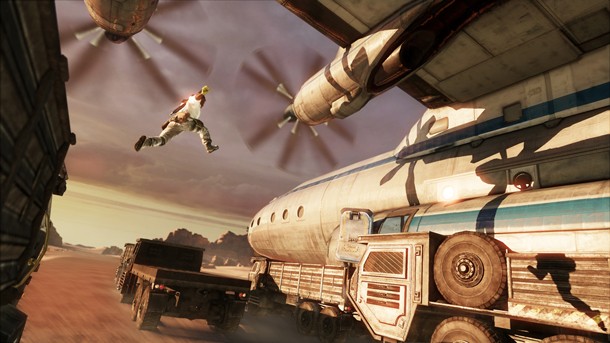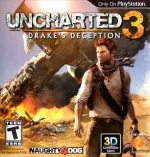Uncharted 3: Drake's Deception

Late last week at a Sony press event we got the chance to sit down with Justin Richmond, game director for Uncharted 3: Drake's Deception. We chatted about the changes between Uncharted 2 and Uncharted 3, crazy dynamic multiplayer maps, and booster balancing.
Tell me about the multiplayer changes from Uncharted 2 to Uncharted 3 that might be easy to miss.
The simplest one is that we put auto-pickup in the game on the grenades and guns. Because of that you never will miss a grenade on the ground because you accidentally tried to pick up a gun. It’s amazing how frustrating that is when you don’t have that [feature]. Basically, in the last game when you were running around and all the guns were on the ground, and you were trying to pick up the one you wanted, it was very difficult because there would be stacks of weapons. Now, first of all, you can customize your guns, so now it’s less likely that you’re going to go and try to pick up someone else’s gun because it’s been modded the way they want it. Usually you would only do that if you ran out of ammo. So that helps a little bit as well. On top of that, auto-picking up any gun that’s the same as yours just gives you the ammo. Running past the grenade gives you the grenade. Because of that it’s faster, it doesn’t slow the game down. Those things – when we go back and play Uncharted 2 – just feel like they kill the pace a little bit, and it’s a really nice addition, and you kind of forget about it.
On top of that we have late join. It’s one of those things that doesn’t look flashy, but it’s super important. In the last game we couldn’t add players after the game started. So when people quit the game got depopulated. Now we can replace them on the fly. If you want the game to have five guys on each team , it will have five guys on each team if there are enough people online, which is awesome. So the game plays the way we intended it to be played, even if people quit, which is really cool.
Why did you decide to finally include free-for-all mode in Uncharted 3?
First of all, we felt like we were trying to do something different with the last game. We wanted to really push and enhance the team-based play. In this game we have this whole buddy system, where in team modes you can spawn in on your buddy and your partner in the game. We wanted to have something that’s different than that, a different kind of mode. So adding deathmatch kind of fulfilled that role. On top of that it gives us the ability to add all kinds of crazy gametypes that you just can’t do in team modes. One of the things that we found is that when we were messing around with our system to update the game on the fly and put different kinds of game modes in, we were really limited because we didn’t have the ability to assign everyone to different teams. When you want to do crazy stuff it made it easier for us to say “I can put x number of guys on a team and x number of guys on another team” and it will still work. Making that much more free form was very important to us.
Tell me more about the Buddy System.
We noticed in all our internal playtests and even watching clips online that people captured – the game plays the best when you stick together. When there’s another partner around to help you out. You can encourage that through gameplay. The buddy system takes that to another level. Let’s say you and I join the game together and we’re always going to be buddies. If you join a game by yourself you’ve going to be assigned a buddy. Because of that it means you can run around with your buddy and spawn on him if you die, and he can spawn on you. So it leads to these scenarios where you’re fighting somebody and you die and your buddy stays alive and you’re like “back off and wait for me to respawn so we can go in and get this guy.” It leads to these more interesting tactical scenarios. On top of that it gives you the ability to do these cool things like when you do a buddy action – like you get an assist while I kill a guy, we now have the ability to say that was a buddy action and put up an icon on screen. If you go high five over the body you get more cash. It’s a cool way to encourage the players to play together and really use the system in interesting ways. It doesn’t require it. You don’t have to do it. But the game definitely feels better when you do.
What changes have you made with the booster upgrade system?
In Uncharted 2 we had a bunch of boosters that you earned through a progression and when you got to the end of the progression I think it sort of felt like there were two [booster] builds that were appropriate and that was about it. And the other ones were kind of placeholder, which sucked. It was not ideal. With this mode what we found is the way we built the boosters out we made them general enough that they can be applied in multiple different ways but specific enough that they give you a real advantage. What we’re seeing in the office playtests is almost individual builds per person. It almost seems like nobody uses the same build. Some people may use the same two boosters but they use a different medal kickback. Or somebody might always use a paid booster to replace one of the other boosters. So you’ll see these crazy builds and you’ll say “what the hell is that guy thinking?” then you watch the way he plays and you’re like “oh, that’s totally perfect for him! I don’t play like that, that’s crazytown.” But for him it gives him the advantage he wants but I’m going to play something with completely different style. It feels like there are a lot of different builds that are interesting and viable and fun. I think it will lead to people experimenting more, so they’ll say “I want to play this way for awhile,” then they’ll see their friend playing this other way and they’ll go “oh, I didn’t even know you could do that.” Because there are enough of them and there are enough different permutations, there are a lot of different ways to play, which is really cool.
How did you go about adding Power Plays without infuriating the winning team?
Basically the idea is that when you get blown out it sucks, right? It’s always bad news. We wanted to make something that felt like – essentially what it’s doing is giving the losing team a chance to catch up. They can score more points quickly or they can complete an objective and catch up in the score. We wanted to make sure that the winning team wasn’t unfairly punished. When the winning team prevents them from completing that objective they get a lot more cash. So they can get XP faster by preventing the losing team from completing that objective. It’s also really cool because all of a sudden the game shifts – there’s the marked man – and everybody is suddenly like “I’m on defense” and “I’m on offense.” The whole game changes. It leads to the game getting more interesting because you don’t know what’s going to happen or when it’s going to happen. So those things got implemented – at first it felt like a punishment, then started adding XP on top of it and it felt like something that’s really interesting.
I noticed that in the Chateau ruins map the ceiling will collapse on players. What causes this dynamic environment change?
In the Chateau specifically there’s a random timer on the fire. So the fire burns intensely dependent on a variable set in the game itself. In the airstrip sequence it’s a timed event sequence, it’s two minutes long. That’s how long it takes before [the airplane takes off after the chase]. In the airport itself the attack strafing and blowing up, that’s all based on a random timer. You don’t quite know when it’s coming. It’s more of an environmental hazard.
Speaking of the Airfield map, why did you decide to open up the map with a sequence with one team chasing the other for control of an airplane? What went into creating that?
Technically it was very complex. For a long time we were like “oh man, I don’t know if we’re going to be able to pull this off.” And it came together, which is amazing. Robert Cogburn, our lead multiplayer designer, did an amazing job. It was his idea and he shepherded it through and made it absolutely amazing. The technical thing was when you’re moving at 40 miles per hour across a map you have a lot of real estate, so you need so much space that we had to make sure we could render all of that. Also, the cars are moving so fast that we needed to make sure that we could spawn you on the cars and make sure jumping between them all worked. Robert and Sandeep [Shekar], our multiplayer programmer, went to town making sure that stuff worked, which is amazing.
Artistically, we wanted to do it because we wanted to start the map out with a bang, with something really, really cool. To have a mode that almost felt separate from the other modes, or to make it this crazy thing that you do, but not to make it too long. Depending on the mode it doesn’t happen. In free-for-all we don’t have that event, it’s only in team deathmatch. In custom games we’ll probably give you the option to turn it on or off if you want.
Can we look forward to more of those spectacular sequences in other maps?
For sure, we’re working on all this stuff right now, obviously, and it’s not final yet. But the idea is to have the cool events you’re seeing in these [Chateau and Airfield] maps in every map. Depending on what it is, how dynamic it is, or whether it’s random, or whether it’s player-triggered, that stuff depends on the map. But the idea is that every map will have something like this in it.
[Check out screenshots the trailer for Uncharted 3's multiplayer here]

Get the Game Informer Print Edition!
Explore your favorite games in premium print format, delivered to your door.
- 10 issues per year
- Only $4.80 per issue
- Full digital magazine archive access
- Since 1991










